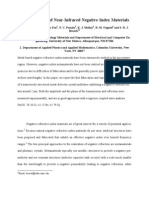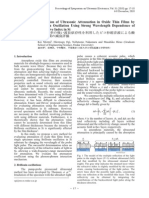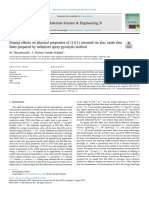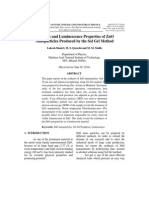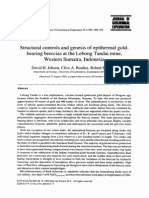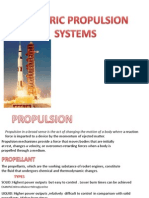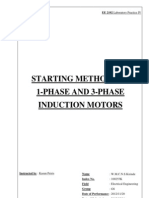Optics Communications: Y.H. Wang, Y.M. Wang, J.D. Lu, L.L. Ji, R.G. Zang, R.W. Wang
Optics Communications: Y.H. Wang, Y.M. Wang, J.D. Lu, L.L. Ji, R.G. Zang, R.W. Wang
Uploaded by
Zahra AdlCopyright:
Available Formats
Optics Communications: Y.H. Wang, Y.M. Wang, J.D. Lu, L.L. Ji, R.G. Zang, R.W. Wang
Optics Communications: Y.H. Wang, Y.M. Wang, J.D. Lu, L.L. Ji, R.G. Zang, R.W. Wang
Uploaded by
Zahra AdlOriginal Title
Copyright
Available Formats
Share this document
Did you find this document useful?
Is this content inappropriate?
Copyright:
Available Formats
Optics Communications: Y.H. Wang, Y.M. Wang, J.D. Lu, L.L. Ji, R.G. Zang, R.W. Wang
Optics Communications: Y.H. Wang, Y.M. Wang, J.D. Lu, L.L. Ji, R.G. Zang, R.W. Wang
Uploaded by
Zahra AdlCopyright:
Available Formats
Optics Communications 283 (2010) 486489
Contents lists available at ScienceDirect
Optics Communications
journal homepage: www.elsevier.com/locate/optcom
Nonlinear optical properties of Cu nanoclusters by ion implantation in silicate glass
Y.H. Wang a, Y.M. Wang b,*, J.D. Lu a, L.L. Ji a, R.G. Zang a, R.W. Wang a
a b
Hubei Province Key Laboratory of Systems Science in Metallurgical Process, Wuhan University of Science and Technology, Wuhan 430081, China Department of Nephrology, Union Hospital, Tongji Medical College, Huazhong University of Science and Technology, Wuhan 430022, China
a r t i c l e
i n f o
a b s t r a c t
Metal nanocluster composite glass prepared by 180 keV Cu ions into silica with dose of 1 1017 ions/cm2 has been studied. The microstructural properties of the nanoclusters were analysed by optical absorption spectra and transmission electron microscopy (TEM). Third-order nonlinear optical properties of the nanoclusters were measured at 1064 nm and 532 nm excitations using Z-scan technique. The nonlinear refraction index, nonlinear absorption coefcient, and the real and imaginary parts of the third-order nonlinear susceptibility were deduced. The mechanisms responsible for the nonlinear response were discussed. Absolute third-order nonlinear susceptibility v3 of this kind of sample was determined to be 2.1 107 esu at 532 nm and 1.2 107 esu at 1064 nm, respectively. 2009 Elsevier B.V. All rights reserved.
Article history: Received 25 August 2009 Received in revised form 17 October 2009 Accepted 17 October 2009
PACS: 61.46.Df 61.72.Ww 42.65.Hw Keywords: Ion implantation Cu nanoclusters Optical nonlinearity Z-scan
1. Introduction Metal nanoclusters possess linear and nonlinear optical properties. Increased attention has focused on the third-order nonlinear susceptibility and the photorefractive effect of noble-metal clusters embedded in dielectric matrices [13]. Third-order nonlinearities of metal/dielectric composite materials are inuenced not only by the type and size of the embedded metal clusters, but also by the dielectric constant, thermal conductivity and heat capacity of the dielectric matrices [16]. The most conspicuous manifestation of connement in optical properties of metal nanocluster composite glasses (MNCGs) is the appearance of the surface plasmon resonance (SPR) that strongly enhances their linear and nonlinear responses around SPR wavelength [79]. Amongst the nanoclusters studied by earlier papers, high nonlinear absorption and nonlinear refraction coefcients are found in copper and copper containing nanomaterials [1012]. Ion implantation has been utilized to produce high-density metal colloids in glasses. The high precipitate volume fraction and the small size of nanoclusters in glasses lead to the generation of thirdorder susceptibility much greater than those for metal doped solid. The third-order nonlinear optical responses of the metal nanoclus-
ter-glass composites can be understood in the framework of dielectric and quantum connement effects. Application aspects of the material are the most relevant to the change of optical properties versus the nanocluster structure. In this paper, MNCGs were prepared by Cu+ implantation into silica. We focused our interest on studying the nonlinear optical properties of this kind of metal nanoclusters. Nonlinear optical properties were measured by Z-scan method under the wavelength of 532 and 1064 nm.
2. Experiment Silica slides were implanted at room temperature with copper ions at 180 keV. The current density of ion implantation was 1.5 lA/cm2. Optical absorption spectra was recorded at room temperature by using a UVvis dual-beam spectrophotometer with wavelengths from 1200 to 300 nm. Transmission electron microscopy (TEM) observations were carried out with a JEOL JEM 2010 (HT) microscope operated at 200 kV. TEM bright eld images were used to determine the size distribution, and the shape of nanoclusters. The measurements of third-order nonlinear optical of the sample were carried out by using the standard Z-scan method. The excitation source was a mode-locked Nd:YAG laser (PY61-10, Continuum), with a pulse duration of 38 ps and a repetition frequency
* Corresponding author. Tel.: +86 27 61094568. E-mail address: wyh61@163.com (Y.M. Wang). 0030-4018/$ - see front matter 2009 Elsevier B.V. All rights reserved. doi:10.1016/j.optcom.2009.10.035
Y.H. Wang et al. / Optics Communications 283 (2010) 486489
487
of 10 Hz. 1064 nm wavelength and doubled frequency (532 nm) were used for excitation in the experiment. The detector was a dual-channel energy meter (EPM2000). With a converging lens of f = 260 mm, the radiuses of the Gaussian beam spot at focal waist -0 were about 45 and 26 lm for 1064 and 532 nm, respectively. In the Z-scan test, the sample was moved step by step along the propagation direction of the Gaussian beam under the control of a PC. Meanwhile, a detector monitored the transmitted laser power and the signals were sent back to the computer and recorded. Nonlinear refraction and nonlinear absorption were performed by both open- and closed-aperture Z-scans of a series of the samples at room temperature. 3. Result and discussion The TEM micrograph for the sample implanted by 1 1017 Cu+ ions/cm2 is shown in Fig. 1. As can be seen from the image, spherical copper clusters are formed during the implantation process. It is interesting to observe nanoclusters with bright centers are indicated with arrows. Our previous study showed that these nanoclusters are hollow Cu nanoshells [13,14]. As can be seen from the image, the particle size distribution is not uniform. The size of nanoclusters varies from 1 to 15 nm. Then the comparative size distribution of Cu nanoclusters is shown in Fig. 2. The average size of nanoclusters in this sample is 5.6 nm. The linear optical absorption spectra of the sample investigated is shown in Fig. 3. The spectra ranges between 200 and 1200 nm. The plasmon resonant absorption peak near 570 nm was observed for the sample. The dependence of this absorption band on the mean cluster diameter has been reported, and it has been shown that the band becomes noticeable and sharpens only when the diameter is about larger than 5 nm [15,16]. This looks like an increasing shoulder than a peak for sample because the morphology of the nanoclusters is complex: the largest nanoclusters show hollow shell structure, which are indicated with arrows, while the smallest ones are single-phase. Therefore, the MNCGs are composed of Cu nanoshells and Cu nanoclusters. The Cu cluster sizes estimated from the absorption spectra are thus consistent with the values obtained from Fig. 2. This selective absorption band is due to the surface plasmon resonance (SPR) and provides extra evidence of Cu nanoclusters formation. The various multipoles excitations may compensate each other and lead to large apparent widths of the resonances.
0.3
0.2
percentage
0.1 0.0 0 2 4 6 8 10 12 14
Diameter/nm
Fig. 2. Comparatively size distribution proles of 1 1017 Cu+ ions/cm2 nanoclusters in silica sample.
2.0
1.5
Optical density (a.u.)
532 nm
1.0
1064 nm
0.5
0.0 200 400 600 800 1000 1200
Wavelength (nm)
Fig. 3. Optical absorption spectra of the Cu implanted sample to dose of 1 1017 ions/cm2.
The nonlinear absorption in the sample can be described as b, which includes saturated absorption (SA) and reversed saturated absorption (RSA) [17]. The nonlinear absorption is expressed as a a0 bI, where a0 is the linear absorption coefcient of the sample and I is the intensity of the laser. The third-order nonlinear absorption and refraction are investigated by Z-scan techniques [18]. These techniques are simple and the sensitive for studying nonlinear optical properties and determining the sign of the nonlinear refractive and absorption indices. The open- and closedaperture Z-scan curves are theoretically tted by [18]:
1 x2 m m 13=2 4DU0 x Tz 1 2 x 9x2 1
m0
Tz
1 X
q0 zm
m P 0
1 2
Fig. 1. Cross-sectional TEM image for the sample implanted by 180 keV, 1 1017 Cu+ ions/cm2.
where x = z/z0, T is the normalized transmittance and z is the distance along the lens axis in the far eld. The nonlinear absorption coefcient b can be obtained by q0 bI0 Leff , where I0 is the intensity of the laser beam at the focus (z = 0), Leff is the effective thickness of the sample, which can be calculated from the real thickness L and the linear absorption coefcient a0 , in the form
488
Y.H. Wang et al. / Optics Communications 283 (2010) 486489
of Leff 1 expa0 L=a0 . The nonlinear refractive index is calculated by DU0 2p=kcI0 Leff , where 2p=k is the wave vector of the incident laser. Normalized open-aperture Z-scan of sample is displayed in Fig. 4(a). The open-aperture measurement shows an obvious enhanced transmittance near the focus, occurring due to the saturation of absorption. This reveals negative nonlinear absorption coefcient. For visible light and for particle diameters d 6 k, k is the vacuum wavelength of the optical wave, only the electric-dipole contribution to the re-radiated optical eld needs to be taken into account. Metal valence electrons move freely inside the sphere. The particles form a strong dipole in applied electric eld, enhancing the local eld and the polarization of dielectric [19]. The excitation wavelength of 532 nm is close to the SPR peaks of this sample, in which Cu nanoclusters display the stronger saturable absorption performance. The nonlinear refraction index is obtained by the ratio of closedaperture data divided by the open-aperture data [18,20]. Results on nonlinear refractive index measurements by the Z-scan technique is show in Fig. 4(b) (closed-aperture data divided by the openaperture data), the peakvalley conguration indicates the negative sign of the nonlinear refractive index (n2 < 0). Third-order nonlinear optical property of the sample at 1064 nm is shown in Fig. 5, the open-aperture Z-scan shows no nonlinear signal, which indicates that the sample has no nonlinear absorption at 1064 nm. A self-defocusing refraction also is found from the peakvalley curve of closed-aperture data. The nonlinear property of the bare silica substrate is measured and gets no detectable change of the transmitted intensity under same Z-scan conditions. Also, it is noticed that if the laser peak intensity is larger than 15 GW/cm2, there is a probability for the high absorbing materials to be damaged at the tested point due to accumulative heating. This heating will produce an ablation hole. The closed-aperture Z-scan curve of the ablation hole is symmetric and has a peakvalley pattern, which is similar to materials with negative nonlinear refraction [21]. So the peak intensity of 0.9 GW/cm2 is selected for the sample at 532 nm and 0.38 GW/cm2 at 1064 nm. In our experiment, the asymmetric curve does not show signicant change when repeated at the same point, suggesting no formation of the ablation hole in this sample during the Z-scan. In our experiments, Leff (nm) for sample is 65 nm. The solid curve in Fig. 4(a) is tted by using Eq. (1) with the experiment parameters and the nonlinear absorption coefcient obtained are b = 458 cm/GW for 532 nm. Fitting the Z-scan data of the closed-aperture with Eq. (2), we get values of c % 1.3 1010 cm2/W for 532 nm and c % 1.1 1010 cm2/W for 1064 nm. The absolute value of third-order nonlinear susceptibility v3 for Cu+ implanted sample is calculated using the following equations [18,20]:
2.0 1.8
Normalized Transmittance
1.6 1.4 1.2 1.0 0.8 0.6 0.4 0.2 0.0 -30
Experiment Theoritical fit
-25
-20
-15
-10
-5
10
15
20
25
30
Z (mm)
Fig. 5. Z-scan experiment results for 1064 nm normalized close-aperture. Solid line: theoretical curve.
DT pv 0:4061 S0:25 jD/0 j
Rev3 2n2 e0 cc 0 Imv k=2p e h i1=2 3 3 vRe 2 vIm 2 :
3
3 4 5 6
n2 0 cb 0
Thus, we obtain the absolute value of v3 are 2.1 107 esu for 532 nm and 1.2 107 esu for 1064 nm. In general the resonant susceptibilities should be much larger than that of nonresonant one. It is shown that v3 is same order at 532 and 1064 nm. This implies that the nonlinear absorption effect on sample is not dominated. Optical Kerr effect play an equally important role in the resonant region. Table 1 lists this work on a comparison between the literature and our results. Tanahashi et al. [8] detected negative value for Im v3 in silica containing copper clusters. We nd our data is twice as large as theirs, and it is probably due to the low pulse duration were used (150 fs). Ganeev et al. [22] studied the optical nonlinearities of different metal colloidal solutions by Z-scan, nding negative v3 values for the gold and copper cases at the initial stages of aggregation. Cattaruzza et al. [23] considered the localeld enhancement factor strongly depended on the particle (Au/ Ag alloy) size and composition. The third-order nonlinear response of the present composite material thus mainly originates from electronic effects in copper nanoclusters. These electronic contributions are due to both intraband and interband transitions. The rst one corresponds to transitions within the conduction band
Normalized Transmittance
Normalized Transmittance
2.0 1.8 1.6 1.4 1.2 1.0 0.8 -20 -10 0 10 20
Experiment Theoritical fit
2.0 1.8 1.6 1.4 1.2 1.0 0.8 0.6 0.4 0.2 0.0 -20 -10 0 10 20
Experiment Theoritical fit
Z (mm)
Z (mm)
Fig. 4. Z-scan experiment results for 532 nm normalized open-aperture (a) and the divided result (b). Solid line: theoretical curve.
Y.H. Wang et al. / Optics Communications 283 (2010) 486489 Table 1 Comparison between the literature and our results. Samples Cu/SiO2 lms [8] Cu colloidal solutions [22] Cu colloidal solutions [22] Ag lms [23] Au/Ag alloy lms [23] Cu/SiO2 composition Cu/SiO2 composition Excitation wavelength(nm) 590 532 1064 527 527 532 1064 Pulse duration 150 fs 35 ps 35 ps 6 ps 5 ns 38 ps 38 ps Repetition rate (Hz) Peak intensity 1 lJ (pulse energy) 40 GW/cm2 400 GW/cm2 10.7 GW/cm2 1.6 GW/cm2 0.9 GW/cm2 0.38 GW/cm2 Phase of
489
v3 (esu)
1 1 10 10
1.8 1010 esu (19.0 9.5) 1015 (5.8 2.9) 1015 (5.9 1.0) 1010 (9.2 1.5) 109 (2.1 1.0) 107 (1.2 0.6) 107
and the second one to transitions from the upper levels of the lled d band to the levels above the Fermi level in the conduction band. Whereas only intraband contribution to the nanoclusters intrinsic third-order susceptibility is thought to be size-dependent, it is dominated by the size-independent interband contribution in the SPR spectral domain. In the case where the clusters are excited by ultra-short laser pulses a hot electron phenomenon may superimpose on the pure electronic nonlinear contributions to v3 [24]. Refractive index changes due to thermal nonlinearities arise due to density changes in the materials propagating with acoustic wave speed caused by heating. In this paper, because absorption at 532 nm is very high, intra-pulse thermal effects could still be present even for ps pulses. A refractive index changes in accordance to relation Dntherm dn=dTDT. dn=dT derivative of MNCGs prevailing negative sign, thus leading to the self-defocusing of a laser beam propagated through a medium [18]. An order of magnitude estimate of the thermal contribution may be presented. dn=dT for silicate glasses is positive (11.9 106/C) [25]. As for composite materials, dn=dT could be negative for the samples with high concentration of nanoparticles in specic wavelength regions [26]. Our studies have shown the negative sign of refractive index in 532 nm is about 3.4 108 esu due to thermal effect. Because the magnitude of n2 is about 1.4 107 esu in this experiment, therefore, thermal effect on the contribution of nonlinear refraction roughly one quarter. Thermal heating induced by a single laser pulse persists over some characteristic time tc. As a result, when the time interval between consecutive laser pulses is shorter than tc, the thermal effect increases. It is a common assumption that Z-scan measurements should be made with repetition rate of few of Hertz in order to extract a nonlinear refractive index inuenced by only electronic effects. The time scale of this cumulative process is given by tc = -0 2/4D, where D is the thermal diffusion coefcient of the materials. Generally, the value of D ranges from 1 107 m2/s to 6 107 m2/s. The magnitude of the calculated tc is within 103 s, which is much smaller than the time interval between consecutive laser pulses 0.1 s used in our experiment [27]. Longer pulse duration of the excitation wavelength lead to combined mechanisms including both optical processes of quick response time and slower ones. Excitation frequency is another cause of the variance. Various wavelengths may induce different nonlinear optical transitions. Moreover, for diverse preparation techniques, Cu+ implanted nanostructure samples differ in size and shape as well as surface structure lms, which are the same in the nonlinear optical behaviors. In this work, the formations of Cu nanoclusters incorporated into silica will give a new possibility in the study of the nonlinear optical response. 4. Conclusion In summary, Cu nanoclusters in silica have been formed by the ion implantation of Cu+ ions. The nonlinear optical property of this
sample was investigated by the Z-scan technique. The v3 measured at 532 nm manifests a real part of 1.3 107 esu and an imaginary part of 1.7 107 esu. During the 1064 nm excitation, the sample had no nonlinear absorption and v3 is 1.2 107 esu which all come from nonlinear refraction contribution. The results show that this structure metal nanoclusters will give a valuable reference in the study of the metal nonlinear optical response. The further studies are in progress. Acknowledgment This work was supported by the Natural Science Foundation of China (No. 10805035). References
[1] G. Battaglin, P. Calvelli, E. Cattaruzza, F. Gonella, R. Polloni, G. Mattei, P. Mazzoldi, Appl. Phys. Lett. 78 (2001) 3953. [2] Y.H. Wang, J.D. Lu, R.W. Wang, Y.L. Mao, Y.G. Cheng, Vacuum 82 (2008) 1220. [3] J. Olivares, J. Requejo-Isidro, R. Del Coso, R. de Nalda, J. Solis, et al., J. Appl. Phys. 90 (2001) 1064. [4] Y.H. Wang, F. Ren, Q.Q. Wang, D.J. Chen, D.J. Fu, C.Z. Jiang, Phys. Lett. A 357 (2006) 364. [5] R.F. Haglund Jr., L. Yang, R.H. Magruder, J.E. Wittig, K. Becker, R.A. Zuhr, Opt. Lett. 18 (1993) 373. [6] Y.H. Wang, C.Z. Jiang, F. Ren, Q.Q. Wang, D.J. Chen, D.J. Fu, J. Mater. Sci. 42 (2007) 7294. [7] A.I. Ryasnyanskiy, B. Palpant, S. Debrus, U. Pal, A.L. Stepanov, Opt. Commun. 273 (2007) 538. [8] I. Tanahashi, H. Inouye, K. Tanaka, A. Mito, Jpn. J. Appl. Phys. 38 (1999) 5079. [9] P. Wang, Y. Lu, L. Tang, J. Zhang, H. Ming, J. Xie, F.H. Ho, H.H. Chang, H.Y. Lin, D.P. Tsai, Opt. Commun. 229 (2004) 425. [10] Y.H. Wang, C.Z. Jiang, F. Ren, Q.Q. Wang, D.J. Chen, D.J. Fu, Phys. E 33 (2006) 244. [11] Y.H. Wang, C.Z. Jiang, X.H. Xiao, Y.G. Cheng, Phys. B 403 (2008) 2143. [12] Y.H. Wang, S.J. Peng, J.D. Lu, R.W. Wang, Y.G. Cheng, Y.L. Mao, Vacuum 83 (2009) 408. [13] Y.H. Wang, S.J. Peng, J.D. Lu, R.W. Wang, Y.G. Cheng, Y.L. Mao, Vacuum 83 (2009) 412. [14] F. Ren, C.Z. Jiang, Y.H. Wang, Q.Q. Wang, D.J. Chen, Y. Shi, Nucl. Instr. Meth. B 245 (2006) 427. [15] R.H. Magruder III, R.F. Haglund Jr., L. Yang, J.E. Wittig, R.A. Zuhr, J. Appl. Phys. 76 (1994) 708. [16] Y. Takeda, V.T. Gritsyna, N. Umeda, C.G. Lee, N. Kishimoto, Nucl. Instr. Meth. B 148 (1999) 1029. [17] S. Couris, E. Koudoumas, A.A. Rutht, S. Leach, J. Phys. B: At. Mol. Opt. Phys. 28 (1995) 4537. [18] M. Sheik-Bahae, A.A. Said, T.H. Wei, et al., IEEE J. Quant. Electron. 26 (1990) 760. [19] Shiliang Qu, Yawen Zhang, Huajun Li, Jianrong Qiu, Congshan Zhu, Opt. Mater. 28 (2006) 259. [20] M. Sheik-Bahae, D.J. Hagan, E.W. Ban Stryland, Phys. Rev. Lett. 65 (1990) 96. [21] G. Battaglin, P. Calvelli, E. Cattaruzza, R. Polloni, E. Borsella, T. Cesca, F. Gonella, P. Mazzoldi, J. Opt. Soc. Am. B 17 (2000) 213. [22] R.A. Ganeev, A.I. Ryasnyansky, S.R. Kamalov, et al., J. Phys. D: Appl. Phys. 34 (2001) 1602. [23] E. Cattaruzza, G. Battaglin, P. Calvelli, F. Gonella, et al., Compos. Sci. Technol. 63 (2003) 1203. [24] F. Hache, D. Ricard, C. Flytzanis, U. Kreibig, Appl. Phys. A 47 (1988) 347. [25] <http://www.sciner.com/Opticsland/FS.htm>. [26] M. Rashidi-Huyeh, B. Palpant, Phys. Rev. B 74 (2006) 075405. [27] A. Gnoli, L. Razzari, M. Righini, Opt. Express 13 (2005) 7976.
You might also like
- Differential EquationsDocument53 pagesDifferential Equationsrenzenzo9250% (2)
- T3 User Manual PDFDocument11 pagesT3 User Manual PDFrudy wibisonoNo ratings yet
- Sdarticle 2Document4 pagesSdarticle 2Sadaf ZiaNo ratings yet
- Nanohole Sheet ResistanceDocument16 pagesNanohole Sheet ResistanceVahagn MkhitaryanNo ratings yet
- Zinc SulfideDocument8 pagesZinc Sulfideantonio SilvaNo ratings yet
- FTIR and Raman Spectroscopy of Carbon Nanoparticles in SiO2 ZnO and NiO Matrices PDFDocument6 pagesFTIR and Raman Spectroscopy of Carbon Nanoparticles in SiO2 ZnO and NiO Matrices PDFeid elsayedNo ratings yet
- Chatelaine, May 2011Document3 pagesChatelaine, May 2011emediageNo ratings yet
- Formation of Conductive Copper Lines by Femtosecond Laser Irradiation of Copper Nitride Film On Plastic Substrates Xu2015 PDFDocument5 pagesFormation of Conductive Copper Lines by Femtosecond Laser Irradiation of Copper Nitride Film On Plastic Substrates Xu2015 PDFSundry 1000No ratings yet
- Synthesis of Zns / Sodium Hexameta Phosphate Nanoparticles: R. Mohan, B. Rajamannan and S. SankarrajanDocument6 pagesSynthesis of Zns / Sodium Hexameta Phosphate Nanoparticles: R. Mohan, B. Rajamannan and S. SankarrajanphysicsjournalNo ratings yet
- Experimental Determination of The Principal Dielectric Functions in Silver Nanowire MetamaterialsDocument4 pagesExperimental Determination of The Principal Dielectric Functions in Silver Nanowire MetamaterialsMuhammad YunusNo ratings yet
- Al Asady2020Document8 pagesAl Asady2020Shifa ChaudhariNo ratings yet
- NO O S Z O N: Ptical Ensing in N AnostructuresDocument4 pagesNO O S Z O N: Ptical Ensing in N AnostructuresSadaf ZiaNo ratings yet
- 1pa 1 PDFDocument2 pages1pa 1 PDFMauricio TerrazasNo ratings yet
- Laising Feom Single ZnODocument4 pagesLaising Feom Single ZnOSadaf ZiaNo ratings yet
- Photoacoustic Studies of Annealed Cdsxse1-X (X 0.26) Nanocrystals in A Glass MatrixDocument6 pagesPhotoacoustic Studies of Annealed Cdsxse1-X (X 0.26) Nanocrystals in A Glass MatrixVigneshwaran MuruganNo ratings yet
- Strong Optical Activity From Twisted-Cross Photonic MetamaterialsDocument3 pagesStrong Optical Activity From Twisted-Cross Photonic MetamaterialsBaban BaidyaNo ratings yet
- Photon Scanning Tunneling Microscope: Detection of Evanescent WavesDocument5 pagesPhoton Scanning Tunneling Microscope: Detection of Evanescent Wavescuongtran_siegenNo ratings yet
- Structural and Optical Properties of Mn-Doped Tin Oxide Thin FilmsDocument6 pagesStructural and Optical Properties of Mn-Doped Tin Oxide Thin FilmsInternational Journal of Application or Innovation in Engineering & ManagementNo ratings yet
- Opt Quant Electron Vo. 41, No.3,2009Document14 pagesOpt Quant Electron Vo. 41, No.3,2009rsdubeNo ratings yet
- 2005 LinDocument4 pages2005 LinRodolfo Angulo OlaisNo ratings yet
- Far-Infrared Spectrally Selective LiTaO3 and A1N Pyroelectric Detectors Using Resonant Subwavelength Metal Surface StructuresDocument8 pagesFar-Infrared Spectrally Selective LiTaO3 and A1N Pyroelectric Detectors Using Resonant Subwavelength Metal Surface Structuresppc.sodeporeNo ratings yet
- Synthesis of Zno Nanowires and Nanobelts by Thermal EvaporationDocument4 pagesSynthesis of Zno Nanowires and Nanobelts by Thermal EvaporationA_ElmahalawyNo ratings yet
- Znosolgel 2006Document4 pagesZnosolgel 2006Pugazh VadivuNo ratings yet
- Negative Index of Refraction in OpticalDocument3 pagesNegative Index of Refraction in OpticaldickNo ratings yet
- W. Liu Et Al - Femtosecond Laser Pulse Filamentation Versus Optical Breakdown in H2ODocument15 pagesW. Liu Et Al - Femtosecond Laser Pulse Filamentation Versus Optical Breakdown in H2OPocxaNo ratings yet
- Science Direct Photoluminescence From Colloidal Silver NanoparticlesDocument6 pagesScience Direct Photoluminescence From Colloidal Silver NanoparticlesYu Shu HearnNo ratings yet
- Structural and Optical Characterization of Cu DopeDocument5 pagesStructural and Optical Characterization of Cu DopeSyahrul MuchlisNo ratings yet
- Fabrication of Interdigitated Electrodes Using Molecular Beam Epitaxy and Optical LithographyDocument10 pagesFabrication of Interdigitated Electrodes Using Molecular Beam Epitaxy and Optical LithographyDaniel MarconiNo ratings yet
- 30-40 Ev MirrorDocument3 pages30-40 Ev MirrorDr-Walid FemtosecondNo ratings yet
- Study Some Structural and Optical Properties of Copper Nano FilmDocument6 pagesStudy Some Structural and Optical Properties of Copper Nano FilmInternational Journal of Application or Innovation in Engineering & ManagementNo ratings yet
- Niobium Doping Effects On Tio Mesoscopic Electron Transport Layer-Based Perovskite Solar CellsDocument8 pagesNiobium Doping Effects On Tio Mesoscopic Electron Transport Layer-Based Perovskite Solar CellsBhabani Sankar SwainNo ratings yet
- Raman y FotoluminicenciaDocument5 pagesRaman y FotoluminicenciaAndress GuzmanNo ratings yet
- Formation of Luminescent Emitters by Intense Laser Radiation in Transparent MediaDocument5 pagesFormation of Luminescent Emitters by Intense Laser Radiation in Transparent MediaMelissa FelicianoNo ratings yet
- Ver Ellen 2011Document7 pagesVer Ellen 2011AminKhanNo ratings yet
- BionanoDocument14 pagesBionanoThan TietNo ratings yet
- 32-Article Text-154-1-10-20220605Document18 pages32-Article Text-154-1-10-20220605S A KaleNo ratings yet
- Xianglei Mao, Samuel S. Mao and Richard E. Russo - Imaging Femtosecond Laser Induced Electronic Excitation in GlassDocument14 pagesXianglei Mao, Samuel S. Mao and Richard E. Russo - Imaging Femtosecond Laser Induced Electronic Excitation in GlassPocxaNo ratings yet
- Chemcomm: Chemical CommunicationsDocument5 pagesChemcomm: Chemical CommunicationsBhabani Sankar SwainNo ratings yet
- Thin Film Silicon Nanoparticle UV Photodetector: O. M. Nayfeh, S. Rao, A. Smith, J. Therrien, and M. H. NayfehDocument3 pagesThin Film Silicon Nanoparticle UV Photodetector: O. M. Nayfeh, S. Rao, A. Smith, J. Therrien, and M. H. Nayfehpramod gaikwadNo ratings yet
- Lithography-Advanced MaterialsDocument15 pagesLithography-Advanced MaterialsJaya LohaniNo ratings yet
- EXPERIMENT 8. Monolayer Characterization: Contact Angles, Reflection Infrared Spectroscopy, and EllipsometryDocument9 pagesEXPERIMENT 8. Monolayer Characterization: Contact Angles, Reflection Infrared Spectroscopy, and EllipsometryavniNo ratings yet
- Synthesis and Optical Characterization of Copper Oxide NanoparticlesDocument5 pagesSynthesis and Optical Characterization of Copper Oxide Nanoparticlesrajbharaths1094No ratings yet
- 91Document10 pages91PavithraNo ratings yet
- Wei-Shun Chang Et Al - Low Absorption Losses of Strongly Coupled Surface Plasmons in Nanoparticle AssembliesDocument26 pagesWei-Shun Chang Et Al - Low Absorption Losses of Strongly Coupled Surface Plasmons in Nanoparticle AssembliesYlpkasoNo ratings yet
- 2005 - Plasmonics Localization and Guiding of Electromagnetic Energy in Metal Dielectric StructuresDocument11 pages2005 - Plasmonics Localization and Guiding of Electromagnetic Energy in Metal Dielectric StructuresZeng YunjiaNo ratings yet
- Visible and Infrared Light Pulse Detection With Organic SemiconductorsDocument4 pagesVisible and Infrared Light Pulse Detection With Organic SemiconductorsGabbiano1979No ratings yet
- PHSV01I04P0240Document12 pagesPHSV01I04P0240physicsjournalNo ratings yet
- Article 9Document3 pagesArticle 9Maroc EcoloadNo ratings yet
- Phsv04i03p0119 PDFDocument7 pagesPhsv04i03p0119 PDFphysicsjournalNo ratings yet
- Nano 2003 1231772Document4 pagesNano 2003 1231772GoxseNo ratings yet
- SemDocument17 pagesSemaliveinmoscowNo ratings yet
- Articles: Photoluminescence Properties of Sno Nanoparticles Synthesized by Sol-Gel MethodDocument5 pagesArticles: Photoluminescence Properties of Sno Nanoparticles Synthesized by Sol-Gel MethodVikas PatilNo ratings yet
- Lab Mst613 (Part B)Document10 pagesLab Mst613 (Part B)hyebibieNo ratings yet
- 1026chuah LsDocument4 pages1026chuah LsSoufianeBenhamidaNo ratings yet
- EG 3.39 119_MusaIDocument7 pagesEG 3.39 119_MusaIloubnarymNo ratings yet
- Effect of 1-Thioglycerol As Capping Agent On ZNS Nanoparticles: Structural and Optical CharacterizationDocument4 pagesEffect of 1-Thioglycerol As Capping Agent On ZNS Nanoparticles: Structural and Optical CharacterizationInternational Journal of Science and Engineering InvestigationsNo ratings yet
- Experimental Confirmation at Visible Light Wavelengths of The Backscattering Enhancement Phenomenon of The Photonic NanojetDocument10 pagesExperimental Confirmation at Visible Light Wavelengths of The Backscattering Enhancement Phenomenon of The Photonic NanojetFrontiersNo ratings yet
- CNT1Document104 pagesCNT1tunv2003No ratings yet
- Preparation and Studying Optical Properties of Sprayed Nanostructure Sno Thin FilmsDocument8 pagesPreparation and Studying Optical Properties of Sprayed Nanostructure Sno Thin FilmsInternational Journal of Application or Innovation in Engineering & ManagementNo ratings yet
- Rai - 2013 - Analysis of The Urbach Tails in Absorption SpectraDocument6 pagesRai - 2013 - Analysis of The Urbach Tails in Absorption Spectrahui-yuan.chenNo ratings yet
- Sidorenko The Run-Up in Horizontal JumpsDocument3 pagesSidorenko The Run-Up in Horizontal JumpsZachary LeeNo ratings yet
- Fiz102e TotDocument96 pagesFiz102e TotJorge AdriánNo ratings yet
- Service Manual: CSD-TD31 CSD-TD32Document10 pagesService Manual: CSD-TD31 CSD-TD32parascoliNo ratings yet
- 13 1611Document8 pages13 1611teguh andriantoNo ratings yet
- Exploring The Beam-Plasma InteractionDocument4 pagesExploring The Beam-Plasma InteractionNisa Melis AtıcıNo ratings yet
- Capsule Mod 2Document9 pagesCapsule Mod 2Manasvi MehtaNo ratings yet
- The Pauli Exclusion Principle Is One of The Most ImportantDocument4 pagesThe Pauli Exclusion Principle Is One of The Most Importantrajpal7590No ratings yet
- Sample Question Paper: FIRST YEAR HIGHER SECONDARY EXAMINATION................ 2023Document7 pagesSample Question Paper: FIRST YEAR HIGHER SECONDARY EXAMINATION................ 2023ashlin paul jobyNo ratings yet
- Tri Axis Micro GyroscopeDocument34 pagesTri Axis Micro GyroscopeCharan Macharla'sNo ratings yet
- Epithermal Deposit in Lebong TandaiDocument20 pagesEpithermal Deposit in Lebong Tandaiarief_7No ratings yet
- Augspurger - Improved Colinear Array (1983)Document23 pagesAugspurger - Improved Colinear Array (1983)shuttNo ratings yet
- G.653 - Dispersie FO Monomod (22p)Document22 pagesG.653 - Dispersie FO Monomod (22p)Nae GoguNo ratings yet
- Seismic Velocity AnomalyDocument16 pagesSeismic Velocity Anomalymishrasarad75No ratings yet
- The Art of Soap-MakingDocument324 pagesThe Art of Soap-MakingKristos Bakayiannis88% (8)
- Electric Propulsion SystemsDocument21 pagesElectric Propulsion SystemsSeshagiri Rao SandhyavandanamNo ratings yet
- Yogesh Kumar ThesisDocument123 pagesYogesh Kumar ThesisWoldemariam WorkuNo ratings yet
- 2018Document71 pages2018Kamran AliNo ratings yet
- Unit 3 Practice SheetDocument4 pagesUnit 3 Practice SheetAnamika GuptaNo ratings yet
- Floor VibrationsDocument72 pagesFloor Vibrationssamuel tejeda100% (1)
- Starting Methods of 1-Phase & 3-Phase IMs - 100255KDocument14 pagesStarting Methods of 1-Phase & 3-Phase IMs - 100255KChamath Kirinde100% (2)
- Metacognitive Reading ReportDocument2 pagesMetacognitive Reading Reportvincent lunaNo ratings yet
- WKB ApproximationDocument14 pagesWKB Approximationamitsk144No ratings yet
- Truss Analysis Report Ganesh SirDocument44 pagesTruss Analysis Report Ganesh Sirarshad aliNo ratings yet
- Q2, WEEK 8 S10FE IIh 52Document8 pagesQ2, WEEK 8 S10FE IIh 52CRISTINE MAE AREVALO100% (1)
- Preventa: XPSMC Safety ControllersDocument48 pagesPreventa: XPSMC Safety ControllersJorge Landim CarvalhoNo ratings yet
- Robotics Question BankDocument9 pagesRobotics Question BankZhyayauNo ratings yet
- Paper 01Document10 pagesPaper 01imasha200322No ratings yet
- Process Control Two Mark Questions PDFDocument20 pagesProcess Control Two Mark Questions PDFYouTube YouTube vancedNo ratings yet



